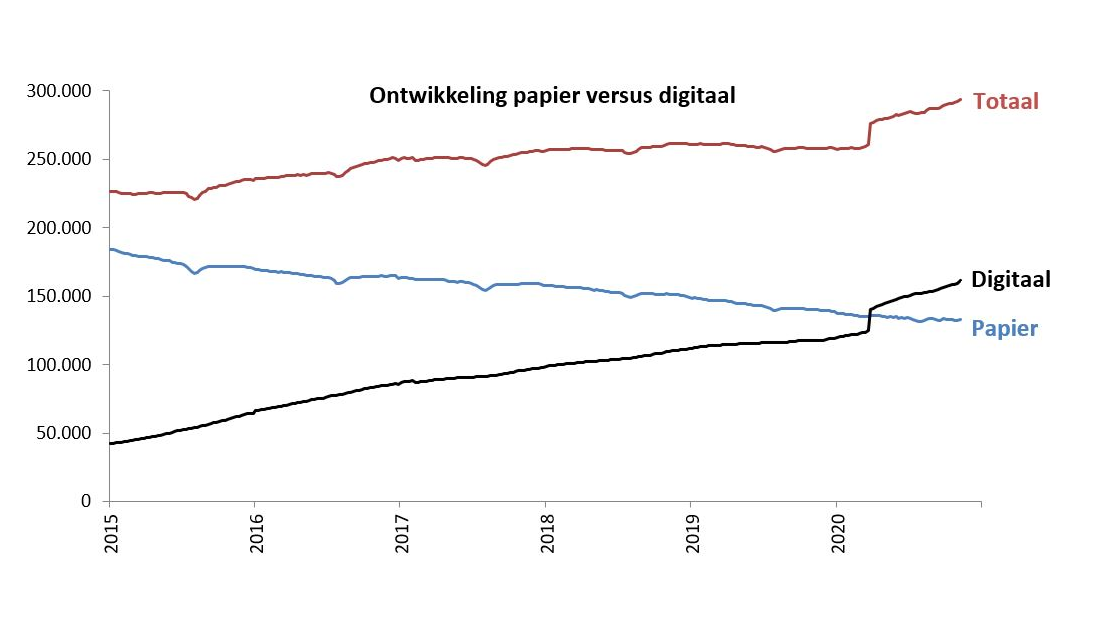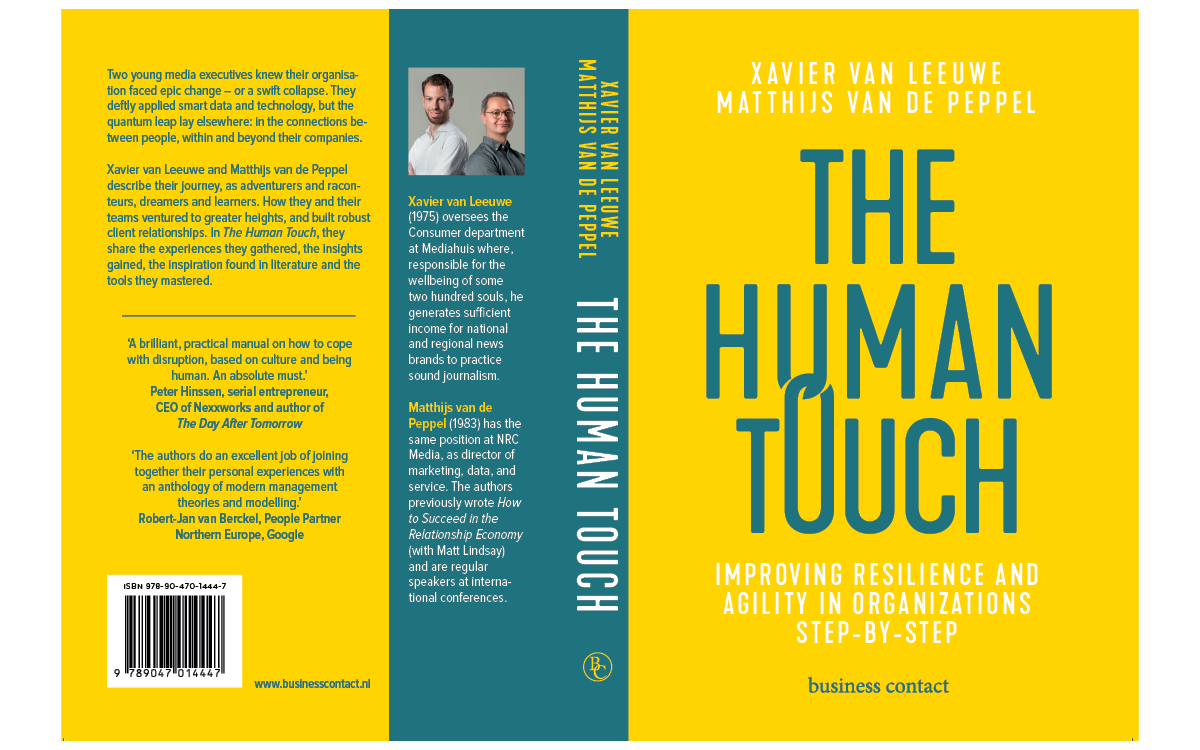INMA Satisfying Audiences Blog | 01 December 2020
By Matt Lindsay
A Discussion with Matthijs van de Peppel of NRC on their recent all-time subscriber level milestone
Matthijs van de Peppel, marketing director for B2C at NRC Media, and I first met during a meeting at the NRC offices in Amsterdam in 2014. That meeting was the beginning of a long collaboration leading to many significant events for both companies.
Van de Peppel and I were co-authors with Xavier van Leeuwe of How to Succeed in the Relationship Economy, published in 2017 in English and later in Dutch and German. Van de Peppel and van Leeuwe recently published a second book discussing their approach to management called The Human Touch in English and Mensenwerk in Dutch.
NRC recently exceeded its prior record number of subscribers and now has the most subscribers in the history of the publication. Van de Peppel agreed to speak with me for this blog post to reflect on the journey to this milestone and to share his view on the significant causes of the growth. He also describes the subject of the new book.
NRC subscriber volumes by product from 2015 to the present are noted in the following chart. The pattern of transition from print to digital platforms is evident. Products include print with digital access to the content with varying levels of print delivery. Six-day print delivery with digital access has experienced a slow decline while Saturday print plus digital and digital-only products have grown. The growth in digital subscriptions is seen in 2020.
NRC subscriber volumes by product from 2015 to the present.
I have summarized my discussion with Matthijs on the changes at NRC in the past six years and the factors that have been important to reaching their recent milestone in this blog post.
What factors are contributing to the subscriber growth?
NRC launched NRC Next, a morning newspaper, in 2006. Subscriptions grew until 2011, when the former all-time high point for subscribers was reached.
NRC experienced declines in circulation from 2011 to 2015, and this is when van Leeuwe and I began changing the way the newspaper was marketed. Several of these marketing tactics were described in our first book, and they included long-term offers, the elimination of trial subscriptions, focusing on the relationship with subscribers, and smart pricing analytics. Subscriptions increased by 25,000 in the next three years and plateaued in 2018 and 2019.
The recent surge in subscriptions is due to factors related to the management tactics deployed within the organisation. In summary, NRC placed significant emphasis on online marketing and added senior team members to the marketing team. The marketing teams moved to an agile way of working, leading to renewed energy, ownership, and innovation across channels. Importantly, the marketing and editorial departments work together closer than ever to join forces, share skills, and use their best journalism for marketing promotions.
The COVID-19 pandemic certainly helped drive subscription growth, but the flywheel was already in place to leverage the increased demand for NRC’s quality journalism. As a result, NRC has grown subscription by another 25,000 since 2019.
How are the marketing teams structured and what is their focus?
NRC has marketing teams for online marketing, reader engagement, and direct marketing. They are multi-skilled, “end-to-end” teams with analysts embedded within the groups. The teams seek insights on the customer journey so they can optimise the touchpoints and messaging. Projects from these teams have improved newsletter conversions, paywall conversions, and other elements of the broader conversion flow, and not only those on the e-commerce site.
These teams define objectives and work toward these goals using an Agile framework. The teams pose hypotheses and develop methods for testing and operationalising insights. They also foster innovation because the teams have the opportunity to define projects. They focus on customer retention and engagement as well as acquisition.
Prior to the collaboration with editorial, the marketing teams and editorial staff often did not know each other. Editorial was on the first floor and marketing was on the fourth. Now, editorial is collaborating closely with all of the marketing teams.
How are data and analytics structured within the organization?
Analysts are distributed across the organisation and live within the business teams (marketing, service, product, and editorial). There is one common source for data, and tools are shared across the organisation to reduce duplication of investment in resources. These analysts are brought together to learn from each other, and to coordinate their priorities and work streams.
What is the subject of the new book?
The Human Touch deals with the human side of innovation. It focuses on the people in the organisation and how they work together. Van Leeuwe and I discuss tools that can be used by managers across industries, and we received feedback from managers in healthcare and other industries adopting our insights. The first book, The Relationship Economy, was about marketing, audience analytics, and operationalising those insights. This book is about the management of people who innovate.
In conclusion
Van de Peppel sent me several copies of the English version of this book, and those books happened to arrive at my office the day of our interview, just in time for the Thanksgiving holiday. The book can be purchased here.
Van Leeuwe is now director of marketing for Mediahuis Netherlands and working at another Mediahuis publication, De Telegraaf, in Amsterdam. He has implemented the marketing tactics from NRC rapidly, and the company is using the same management tools at use in NRC. The result is that De Telegraaf is also experiencing a very strong surge in subscription growth.
It has been a pleasure working with van de Peppel, van Leeuwe, and the Mediahuis teams, and we at Mather Economics offer our congratulations on reaching this new all-time high for subscribers and the inspiring story of NRC and De Telegraaf adapting to disruption. Thank you to van de Peppel for sharing his insights and perspective on reaching this impressive milestone.
The latest book by Matthijs van de Peppel and Xavier van Leeuwe is about managing people who innovate.
Xavier van Leeuwe and Matthijs van de Peppel, two young media executives, knew their organization faced epic change – or a swift collapse. They deftly applied smart data and technology, but the quantum leap lay elsewhere: in the connections between people, within and beyond their companies. Xavier van Leeuwe and Matthijs van de Peppel describe their journey in ‘The Human Touch’, as adventurers and raconteurs, dreamers and learners. How they and their teams ventured to greater heights, and built robust client relationships. In ‘The Human Touch’, they share the experiences they gathered, the insights gained, the inspiration found in literature and the tools they mastered.
‘A brilliant, practical manual on how to cope with disruption, based on culture and being human. An absolute must.’
Peter Hinssen, serial entrepreneur, CEO of Nexxworks and author of The Day After Tomorrow



